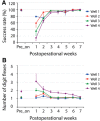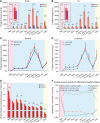Correlated Disruption of Resting-State fMRI, LFP, and Spike Connectivity between Area 3b and S2 following Spinal Cord Injury in Monkeys
- PMID: 29038239
- PMCID: PMC5688527
- DOI: 10.1523/JNEUROSCI.2318-17.2017
Correlated Disruption of Resting-State fMRI, LFP, and Spike Connectivity between Area 3b and S2 following Spinal Cord Injury in Monkeys
Abstract
This study aims to understand how functional connectivity (FC) between areas 3b and S2 alters following input deprivation and the neuronal basis of disrupted FC of resting-state fMRI signals. We combined submillimeter fMRI with microelectrode recordings to localize the deafferented digit regions in areas 3b and S2 by mapping tactile stimulus-evoked fMRI activations before and after cervical dorsal column lesion in each male monkey. An average afferent disruption of 97% significantly reduced fMRI, local field potential (LFP), and spike responses to stimuli in both areas. Analysis of resting-state fMRI signal correlation, LFP coherence, and spike cross-correlation revealed significantly reduced functional connectivity between deafferented areas 3b and S2. The degrees of reductions in stimulus responsiveness and FC after deafferentation differed across fMRI, LFP, and spiking signals. The reduction of FC was much weaker than that of stimulus-evoked responses. Whereas the largest stimulus-evoked signal drop (∼80%) was observed in LFP signals, the greatest FC reduction was detected in the spiking activity (∼30%). fMRI signals showed mild reductions in stimulus responsiveness (∼25%) and FC (∼20%). The overall deafferentation-induced changes were quite similar in areas 3b and S2 across signals. Here we demonstrated that FC strength between areas 3b and S2 was much weakened by dorsal column lesion, and stimulus response reduction and FC disruption in fMRI covary with those of LFP and spiking signals in deafferented areas 3b and S2. These findings have important implications for fMRI studies aiming to probe FC alterations in pathological conditions involving deafferentation in humans.SIGNIFICANCE STATEMENT By directly comparing fMRI, local field potential, and spike signals in both tactile stimulation and resting states before and after severe disruption of dorsal column afferent, we demonstrated that reduction in fMRI responses to stimuli is accompanied by weakened resting-state fMRI functional connectivity (FC) in input-deprived and reorganized digit regions in area 3b of the S1 and S2. Concurrent reductions in local field potential and spike FC validated the use of resting-state fMRI signals for probing neural intrinsic FC alterations in pathological deafferented cortex, and indicated that disrupted FC between mesoscale functionally highly related regions may contribute to the behavioral impairments.
Keywords: electrophysiology; fMRI; functional connectivity; nonhuman primate; spinal cord injury.
Copyright © 2017 the authors 0270-6474/17/3711192-12$15.00/0.
Figures








Similar articles
-
Differential Recovery of Submodality Touch Neurons and Interareal Communication in Sensory Input-Deprived Area 3b and S2 Cortices.J Neurosci. 2022 Dec 14;42(50):9330-9342. doi: 10.1523/JNEUROSCI.0034-22.2022. Epub 2022 Nov 15. J Neurosci. 2022. PMID: 36379707 Free PMC article.
-
Discrete Modules and Mesoscale Functional Circuits for Thermal Nociception within Primate S1 Cortex.J Neurosci. 2018 Feb 14;38(7):1774-1787. doi: 10.1523/JNEUROSCI.2795-17.2017. Epub 2018 Jan 15. J Neurosci. 2018. PMID: 29335352 Free PMC article.
-
Machine Learning-Based Clustering of Layer-Resolved fMRI Activation and Functional Connectivity Within the Primary Somatosensory Cortex in Nonhuman Primates.Hum Brain Mapp. 2025 Apr 1;46(5):e70193. doi: 10.1002/hbm.70193. Hum Brain Mapp. 2025. PMID: 40095731 Free PMC article.
-
Biophysical and neural basis of resting state functional connectivity: Evidence from non-human primates.Magn Reson Imaging. 2017 Jun;39:71-81. doi: 10.1016/j.mri.2017.01.020. Epub 2017 Feb 2. Magn Reson Imaging. 2017. PMID: 28161319 Free PMC article. Review.
-
The neural basis of the blood-oxygen-level-dependent functional magnetic resonance imaging signal.Philos Trans R Soc Lond B Biol Sci. 2002 Aug 29;357(1424):1003-37. doi: 10.1098/rstb.2002.1114. Philos Trans R Soc Lond B Biol Sci. 2002. PMID: 12217171 Free PMC article. Review.
Cited by
-
The neural basis of resting-state fMRI functional connectivity in fronto-limbic circuits revealed by chemogenetic manipulation.Nat Commun. 2024 May 31;15(1):4669. doi: 10.1038/s41467-024-49140-0. Nat Commun. 2024. PMID: 38821963 Free PMC article.
-
Detection and characterization of resting state functional networks in squirrel monkey brain.Cereb Cortex Commun. 2023 Sep 2;4(3):tgad018. doi: 10.1093/texcom/tgad018. eCollection 2023. Cereb Cortex Commun. 2023. PMID: 37753115 Free PMC article.
-
Functional connectivity and amplitude of low-frequency fluctuations changes in people with complete subacute and chronic spinal cord injury.Sci Rep. 2022 Dec 3;12(1):20874. doi: 10.1038/s41598-022-25345-5. Sci Rep. 2022. PMID: 36463248 Free PMC article.
-
Neuromodulation of sensory networks in monkey brain by focused ultrasound with MRI guidance and detection.Sci Rep. 2018 May 22;8(1):7993. doi: 10.1038/s41598-018-26287-7. Sci Rep. 2018. PMID: 29789605 Free PMC article.
-
Correspondence between thalamic injury-induced changes in resting-state fMRI of monkeys and their sensorimotor behaviors and neural activities.Neuroimage Clin. 2025;45:103753. doi: 10.1016/j.nicl.2025.103753. Epub 2025 Feb 11. Neuroimage Clin. 2025. PMID: 39983550 Free PMC article.
References
Publication types
MeSH terms
Grants and funding
LinkOut - more resources
Full Text Sources
Other Literature Sources
Medical
